Farmland Summary I started off with saying-I believe farmland is overvalued so much that farmers will be unable to make their payments and there will be a collapse. Also due to degradation of soil quality from petrochemicals farm productivity is falling and will be unable to keep up with current market and bank loan demands. What do you think? Alan (https://understandingag.com/partners/allen-williams/) responded- I Absolutely agree, he then described to me a situation far worse than I thought. The American farming landscape faces a looming crisis due to overvalued farmland and declining productivity. This situation, described by agricultural experts like Alan Williams, points to an unsustainable future. Farmland appreciation rates outpace agricultural commodity prices. For instance, corn sells at $5 per bushel, yet the costs for row crop farming hover around $1000 per acre, with an average yield barely covering expenses, let alone land costs. Most farmers rely heavily on subsidies, with up to 70% of revenue coming from taxpayer programs. This dependence shifts focus from sustainable farming to 'farming the farm bill,' prioritizing financial gains over soil health. This is the same for Ranching as well. Market demand influences production decisions minimally, with farmers sticking to traditional crops like corn and soybeans. Record-keeping practices vary widely, with little focus on surplus management or anticipating market fluctuations. The commodity timeline reflects a complex chain from farm to consumer, heavily influenced by speculative futures markets. To address these challenges, a realistic financial estimate should consider actual production costs, including living expenses and true yield projections. Farming must move away from chemical additives and subsidies towards a sustainable, free-market approach. However, regulatory inconsistencies and climate concerns complicate this transition. The correction needed involves a significant drop in land values, as current prices far exceed actual agricultural worth. Speculators stand to lose, and a reevaluation of farming practices is essential to avoid a future crisis, including environmental degradation, water scarcity, and food deficits. Encouraging young farmers and prioritizing soil health are critical steps towards a sustainable agricultural future. A global famine is predicted to be in the next 10-20 years if it does not change soil depletion comes from microorganisms being stimulated from artificial additives such as ammonium nitrate which causes the microorganisms to consume carbon within the soil at unprecedented rates that can be replenished in time. The soil naturally containing the carbon as well as sequestration from the plants the carbon is used as somewhat of structural support within the soil allowing water and nutrients to be moved efficiently. Additives such as ammonium nitrate cause ‘soil collapse’ a physical event where the soil crushes in on itself not allowing nutrients and water to move through the soil. The implications of this causes mass dying events within the soils ecosystem which to note there is 1 trillion microbial cells in a single gram of soil. Plants have evolved alongside soil and a healthy plant demands healthy soil. We can artificially create growth in the plant but at the expense of the plant that is not sustainable without an increased amount of additives year over year which is actually a form of depreciation for a variety of reasons. When the soil infrastructure is destroyed during normal rain or mass rain events the water cannot be consumed and retained by the soil causing it to run off. When it runs off it takes the top soil with it which is the most area needed for crop production and ecosystem strength and livability. When the topsoil is washed away it ruins the crop for this season and the next season if not built back in time which likely it won't be able to be built back especially under conventional farming tactics it will only get worse. When the soil strength is gone during these same mass raining events the water is not going in the earth and goes down flood ways and causes mass flooding. This is seen in areas of mass deforestation notably in the global south. Although artificial production increases short term production for minimal capital cost like what was seen in the 1950s it can't be sustained and it is not being accurately depicted in financial modeling Farmers have been given a subsidiary lifeline and credit line that's backed by the US federal government that accounts for 45-70% of farm income. These subsidies are added in when doing the valuation of a farm. Most conventional farms are negative without subsidies. Only positive with the addition of subsidies. Yet, that's what the financial institutions deem is best fit for the valuation of farmland, a false number backed and inflated by the US government. The farmland value is also propped up from market speculation in Chicago, REITs desire to develop all of America, and the core belief that America's farmland and production could never crash. Graphs are not based on real figures but rather depicting the causation effect from our actions and the implications that are not being spoken about.
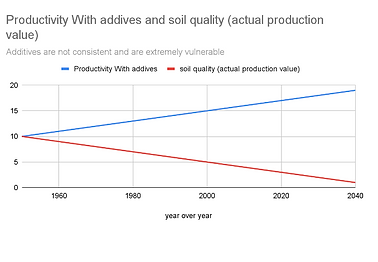
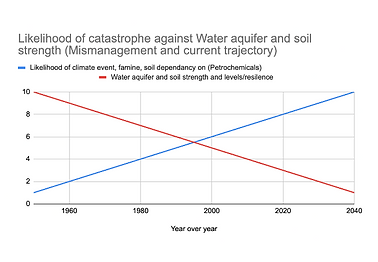
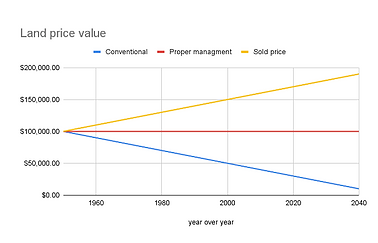

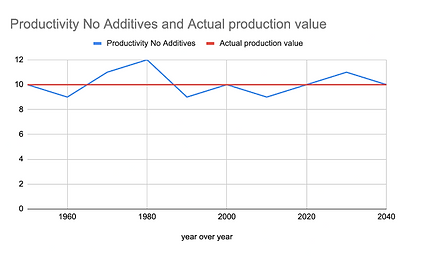
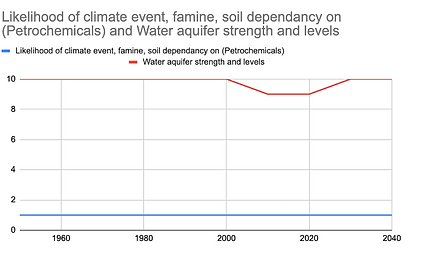

The Relationship between soil and crops There is far more life under the earth's crust than above it. Why? Simple, life started there and it is supported there. The relationship between crops and soil should not be severed if one wants to be a steward of the earth. Often it is thought the reverse that soil and crops are working together rather than crops are independent from it. Within the soil there are microbes, fungi, bacteria, and many more things that are in a constant communication network with one another for survival and reproduction. These organisms are in a barter trading economy. A system of pure trade for one's own gain and the strengthening of relationships, thus increasing their chances of survival and successful reproduction. The organisms underneath have an intricate supply chain of trade for inorganic and organic compounds (phosphorus, nitrogen, glucose), oxygen, water, carbon and many more things which facilitate life. Bartering to one another and strengthening connections to create a highly specialized market where one organism focuses on one task and trades that goods of their labor to another for something they need. A system so advanced that most are unaware of it and those who are aware know they barely know anything of the intricacy. One of the most fascinating things about soil is the relationship between organisms underneath the soil and above the soil. The plants above provide oxygen for aerobic species (these are species which require oxygen) underneath the soil such as mycelium. Oxygen is something that plants so happen to specialize in creating (I.e conversion of carbon dioxide to oxygen). With the Plant-Mycelium partnership the mycelium gives to the plants inorganic compounds and nutrients that the plant needs to build its structure. The plant in return gives valuable glucose and oxygen to the fungi. Mycelium, a single celled fungi species, can reach places that plant roots can't reach. Mycelium also has an interesting relationship with other microbes and plants to effectively and efficiently trade for needed compounds. Something the plant doesn't have as built out as extensive as the fungi network. Fungus spanning further than any plant can go, the plants capitalize off of this relationship. A proper partnership with Mycelium is needed for higher odds in a plant's survival and reproduction. Healthy soil -leads to> Healthy crops -leads to> Healthy animals/farm -leads to> Healthy population and environment. This is an extremely simplified version of what we have observed happening beneath the soil, there are many many more species underneath that are working but mycelium is one of the most studied and observed. The problem with additives in soil This is where it gets interesting. After learning this, one may ask so what's wrong with synthetically adding nitrogen (Fertilizer) into the soil if that's already happening? Well let's first describe nitrogen in a simple manner. Nitrogen being carried underneath the soil is fed to the plant and other microbes. The role of nitrogen is thus: Nitrogen plays a key role in the formation of Chlorophyll, one of the most key functions of photosynthesis. Nitrogen helps plants consume light. Stimulated consumption of light signals to the plant to increase the leaf surface area which requires more carbon. Here is a simple explanation of the usage of carbon within soil. The biology within the soil uses carbon to create ‘structure’ within the soil. A structure that supports the dirt and soil from caving in on itself so that water, information, and species can flow and grow. Carbon is also used for the plant to create its own structure and increase leaf area. When nitrogen is added to the soil the microbiology is hyper-activated and it is believed that plant growth is stimulated and needs an immense amount of carbon. In which it begins to consume the carbon within the soil since this irregular amount of nitrogen was not supplemented with an irregular amount of carbon. This causes the microbiology to do a petrochemical assisted suicide and consumes the carbon that that is supporting the soil. This causes the soil and dirt to literally cave in on itself leading to -soil collapse. Soil compaction increases the risk for crop failure and disease. In this state the soil does not allow the water from the environment to be absorbed within the soil, nor does it allow communication to occur between different species, and plant root size is stunted. Since water is not being effectively absorbed within the soil the water begins to run off taking valuable topsoil with it. (Topsoil is the top layer of soil, typically ranging in depth from 2-10 inches (5-25 cm), that contains a mixture of organic matter, minerals, and other essential elements necessary for plant growth. It is the most fertile and productive part of the soil, making it crucial for plant survival and development). This also leads to floods within a given location. For every increase of soil organic matter by 1% over one acre on a conservative metric an additional 20,000 gallons of water can be held within the soil (Bryant 2015). Over all of US cropland a 1% increase of organic matter is equal to the amount of water from the Niagara Falls in 150 days (Nichols 2015). Soil and organic carbon holds a 1:2 relationship with water holding capacity meaning a 1% increase of organic carbon would result in a 2% increase in water holding capacity. 1% increase in soil organic carbon → 2% increase in water holding capacity 2% increase in soil organic carbon → 4% increase in water holding capacity 3% increase in soil organic carbon → 6% increase in water holding capacity How long does it take to restore or destroy 1 % Organic matter? -I do not have the answer for this but we do know certain practices negatively and positively impact that relationship. In short- The problem with adding nitrogen in the soil is that everything wants nitrogen and when it consumes nitrogen at unnatural rates it will consume carbon at irregular rates, thus causing a simple carbon/soil collapse in the soil and decreases water retention in the given area leading to a multitude of issues such as floods, crop failure, crop disease, and a undiversified microbiological environment. Water In soil Water within soil is an interesting phenomenon to study because: plants attract rain clouds by releasing water vapor through transpiration, increasing humidity levels in their immediate surroundings, and contributing to the formation of cloud nuclei. This process is part of the larger water cycle and plays a role in local weather patterns and precipitation. There is also some other properties in the works that I like to think of for this relationship and thats: the rule of osmosis (the movement of water molecules from an area of high concentration to an area of low concentration through a semipermeable membrane) and that water is attracted to water (Water attracts water because the molecules are polar, leading to the formation of hydrogen bonds between the slightly positive hydrogen atoms of one molecule and the slightly negative oxygen atoms of another). Environments that have water attract water. Environments that don't have any water don't attract water. So when the soil has a high concentration of water and moisture it attracts rain clouds and increases frequency of precipitation. The opposite does the opposite. In theory and observed outcomes, With this intentional agricultural practice we can solve the irregular weather patterns and stabilize our ecosystems. Dirt vs Soil Let's separate two ideas, soil and dirt. Soil is a living system, dirt is simply inanimate small rocks. A teaspoon of healthy soil has billions of life forms within it. These billions of life forms promote the growth of the plant that we see above. When we use pesticides, fungicides, and other chemicals it kills far more ‘healthy’ life than non helpful life and then these chemicals seep into the cell structure of the plant and then we begin to see higher cancer rates (https://www.sciencedirect.com/science/article/abs/pii/S1383574218300887) and birth defects (https://www.scribd.com/document/64933216/Glyphosate-Link-to-Birth-Defects-Report) within adults and children, specifically within high agricultural run off regions such as the Mississippi river. Consequently The ecosystem of soil has been prospering far longer without non-organic chemicals than with them, and that these chemicals have led to a large degradation of the ecosystems. Do not be swayed away or discouraged. It can all be reversed, not by exterminating humans or worsening our quality of life, just by changing human impact. In fact- It would actually take far longer for the ecosystem to repair itself and get better by itself than with intentional human action. Humans can repair the ecosystems afforded to us in a relatively short period of time reversing all of the damage done in the last 300 years (within north America) through regenerative agriculture. It will take a combined effort but it is doable. Takeaways The idea of farming and ranching is not so much to increase the yield of crops and livestock but to increase the amount of sun energy, carbon and water that is consumed by the soil. Because the crop or livestock of one's field is dependent on the life and strength of the soil (as above, so below). The life and vitality of the soil is reflected in the vitality of the plants and grass which is reflected in the health of an animal or human that consumes the plant. The mission is not the reduction of humans or the lowering of the quality of life on the planet. But the increased quality of life and a different type of human impact. Not through the domination or financial strangling of farmers but through a changing of practice which helps the family farmer increase their own strength and the strength of our nation and people. Although this was mostly about plant life and soil health this is the exact same case for ranching. Animals rely on good soil. There is a proper balance for everything. There is a balance for a cycle of: degradation, rehabilitation, and status quo. The question for every steward is what balance do you want to achieve and work towards? Nichols, R. 2015. "A Hedge against Drought: Why Healthy Soil is 'Water in the Bank'." United States Department of Agriculture. Natural Resources Conservation Service. https://www.usda.gov/media/blog/2015/05/12/hedge-against-drought-why-healthy-soil-water-bank Bryant, L. 2015. "Organic Matter Can Improve Your Soil's Water Holding Capacity." NRDC Expert Blog. https://www.nrdc.org/experts/lara-bryant/organic-matter-can-improve-your-soils-water-holding-capacity